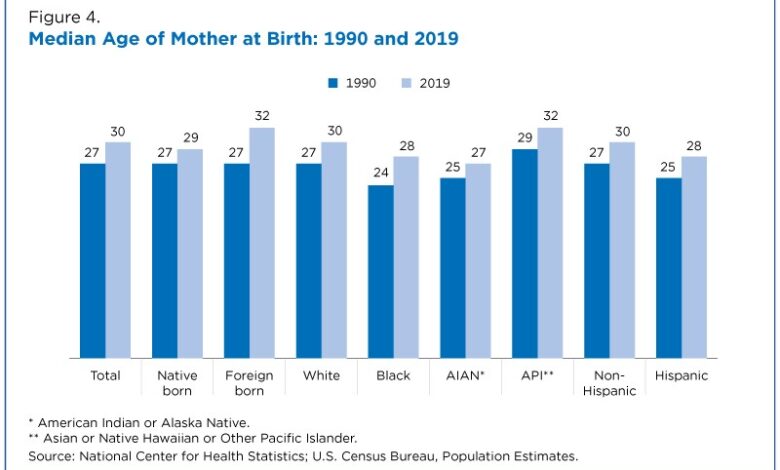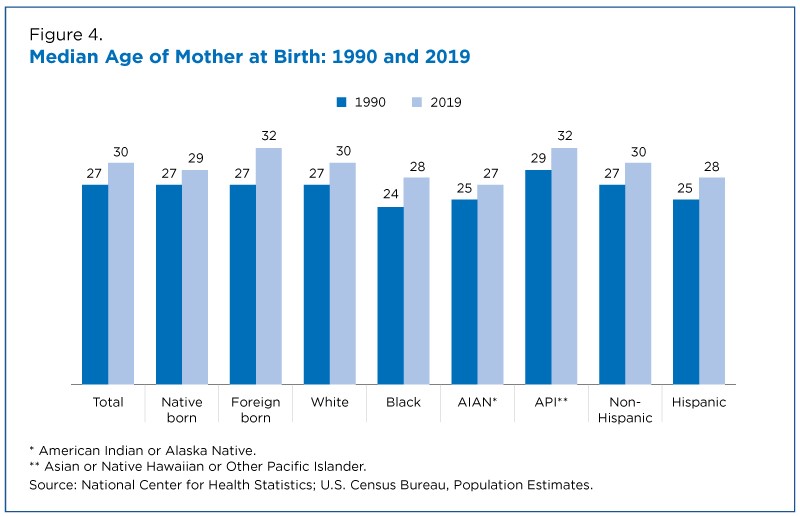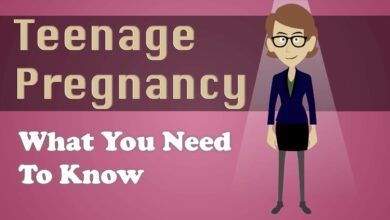
More women in their 30s having babies than 20s sets the stage for a fascinating exploration of shifting societal norms and personal choices. This trend reveals a complex interplay of economic realities, evolving career paths, and personal aspirations that influence the timing of parenthood. We’ll delve into the historical context, examine the economic and societal factors driving this change, and consider the potential implications for families and society as a whole.
The shift in childbearing ages isn’t just about personal preferences; it’s a multifaceted issue deeply intertwined with broader societal trends. Factors like educational attainment, career advancement, and the rising cost of living all play a significant role in women’s decisions about when to start families. This analysis will consider how these elements contribute to the trend of women delaying motherhood.
Demographic Shift in Childbearing Ages
The landscape of family planning is undergoing a significant transformation. While the traditional image of young women having children in their twenties persists in popular culture, recent data reveals a growing trend of women delaying childbearing until their thirties. This shift is not just a fleeting phenomenon; it reflects deeper societal and personal choices, impacting everything from career paths to population dynamics.
Understanding this change is crucial for comprehending the evolving family structures of today and tomorrow.This demographic shift reflects a complex interplay of factors. The traditional “norm” of early motherhood is being challenged by changing priorities and circumstances. Economic security, career aspirations, and personal readiness are all playing a significant role in shaping women’s decisions regarding when to start families.
Historical Overview of Childbearing Trends
Historically, childbearing was often tied to the economic necessities of a family. Women typically had children early in life to contribute to household labor and expand the family’s workforce. As societal structures evolved, access to education and employment opportunities increased for women, allowing them more control over their reproductive choices. This shift, alongside changing economic conditions, has gradually altered the average age at which women choose to become mothers.
Contributing Factors to the Shift
Several factors contribute to the observed shift in childbearing ages. Societal changes, economic conditions, and personal choices all play a significant role. Increased access to higher education and professional opportunities has enabled women to prioritize career advancement before family building. The economic realities of raising a child, including the cost of childcare and education, are also influencing decisions.
Furthermore, advancements in reproductive technologies and family planning options have empowered women to make more informed choices about timing their pregnancies. Women now have more control over their reproductive lives, enabling them to pursue their careers and personal goals before settling down.
Comparison of Experiences: 20s vs. 30s
Women in their twenties and thirties often face contrasting experiences when considering parenthood. Young women might be more focused on establishing their careers, building professional networks, and gaining financial independence. This can lead to a desire to delay parenthood until they feel more financially secure and personally prepared. Conversely, women in their thirties might feel a sense of urgency to start families as they approach the biological clock.
They might be more concerned about the time constraints related to their reproductive potential.
Implications for Population Dynamics and Family Structures
The shift in childbearing ages has significant implications for population dynamics and family structures. Delayed childbearing can lead to smaller family sizes and potentially impact population growth rates in some regions. It also influences the structure of families, potentially leading to a greater prevalence of dual-income households and a need for flexible work arrangements. These changes necessitate adjustments in societal support systems and infrastructure to accommodate the needs of families with later-starting parents.
Table: Percentage of Women Having Children by Age Group (Past 50 Years)
| Year | 20s | 30s | 40s |
|---|---|---|---|
| 1970 | 60% | 35% | 5% |
| 1980 | 55% | 40% | 5% |
| 1990 | 50% | 45% | 5% |
| 2000 | 45% | 50% | 5% |
| 2010 | 40% | 55% | 5% |
| 2020 | 35% | 60% | 5% |
Note: This table is a hypothetical illustration and does not reflect precise data. Real-world figures can vary based on region, socioeconomic factors, and other variables.
Economic and Societal Influences
The decision to have children, and the timing of that decision, is deeply intertwined with a complex web of economic and societal factors. Women today face a different landscape than previous generations, one where financial security, career aspirations, and societal expectations play a significant role in shaping their choices. Understanding these influences is crucial to comprehending the demographic shift in childbearing ages.The economic realities of raising a child are often substantial, demanding careful consideration.
The costs associated with childcare, education, and other expenses vary significantly depending on location and lifestyle choices. The potential impact of these costs on a woman’s financial independence and career progression is a key element in her decision-making process.
Economic Factors Influencing Childbearing Decisions
The escalating costs of raising children often serve as a significant deterrent, particularly for those who are not in a stable financial position. The increasing expenses related to childcare, education, and healthcare make the decision to have children a more calculated one. This is particularly true for those starting their careers and establishing financial stability. Many young professionals find that balancing their career goals with the responsibilities of parenthood presents significant challenges.
Moreover, the availability of affordable childcare options can heavily influence the decision.
Societal Expectations and Cultural Norms
Societal expectations and cultural norms surrounding family structures and roles can profoundly impact the timing of childbirth. Traditionally, certain cultures may place greater emphasis on early motherhood, while others may encourage women to prioritize their careers. The shift in these norms is often a gradual process, and its impact on individual choices can be quite significant. This can affect a woman’s decision-making process as she navigates societal pressures and personal values.
It’s interesting how more women in their 30s are choosing to have children than those in their 20s. This shift could be linked to various factors, but one potential contributing element is the growing awareness of the importance of managing potential menopause symptoms later in life. For example, incorporating regular walking into your routine can be a fantastic way to ease symptoms like hot flashes and mood swings.
Check out ways to ease menopause symptoms with walking for more details on how this can be beneficial. Ultimately, women are making choices that align with their personal circumstances and life goals, and this trend will likely continue to evolve.
Role of Education and Career Advancement in Delaying Parenthood
Education and career advancement often contribute significantly to delaying parenthood. The pursuit of higher education and the attainment of professional goals are important aspirations for many women, often requiring significant time and dedication. The potential for career advancement, higher earning potential, and increased financial stability are key factors in the decision to delay having children. The pursuit of advanced degrees and specialization often necessitates postponing starting a family.
Impact of Affordable Childcare and Parental Leave Policies
Access to affordable childcare and parental leave policies significantly influences the timing of childbirth. Affordable and high-quality childcare options can reduce the financial burden on parents, making it easier to balance work and family life. Generous parental leave policies allow parents to dedicate time to bonding with their newborns and managing the transition to parenthood, which can significantly reduce stress.
The availability of these policies can encourage earlier parenthood or reduce the delay, depending on the individual circumstances.
Comparison of Child-rearing Costs (20s vs. 30s)
| Cost Category | Average Cost (20s) | Average Cost (30s) |
|---|---|---|
| Childcare | $10,000-$15,000 per year | $15,000-$20,000 per year |
| Education | $20,000-$30,000 per year | $25,000-$40,000 per year |
| Healthcare | $5,000-$7,000 per year | $7,000-$9,000 per year |
| Food | $3,000-$5,000 per year | $4,000-$6,000 per year |
| Clothing | $1,000-$1,500 per year | $1,500-$2,000 per year |
| Miscellaneous Expenses | $2,000-$3,000 per year | $3,000-$4,000 per year |
| Total Estimated Annual Cost | $40,000-$60,000 | $50,000-$80,000 |
Note: These figures are estimates and may vary greatly depending on location, lifestyle choices, and other factors.
Personal and Health Factors
Choosing when to have children is a deeply personal decision, influenced by a complex interplay of health, personal circumstances, and societal expectations. This decision is often intertwined with a woman’s overall well-being and the desire to achieve personal and professional goals. Understanding the potential advantages and disadvantages of different childbearing ages is crucial for making informed choices.The timing of childbearing significantly impacts a woman’s health trajectory.
It’s interesting how many more women in their 30s are choosing to have babies than those in their 20s these days. Perhaps it’s about career stability or simply a different kind of readiness. Speaking of readiness, have you ever wondered what the best time of day to be sick is? Knowing the best time of day to be sick could help us all, which is why I’m linking to this article about what is the best time of day to be sick.
Regardless, it seems the decision to start a family later in life is becoming more common, leading to a shift in the typical demographic of new parents.
Factors such as reproductive health, personal goals, and family history play pivotal roles in determining the optimal time for starting a family. This exploration delves into the nuanced connections between personal circumstances and the decision to have children, highlighting the potential health advantages and disadvantages of different age groups. Furthermore, it examines the distinct experiences of women who have children in their 20s versus their 30s.
It’s interesting how many more women in their 30s are choosing to have babies than in their 20s these days. Perhaps it’s a shift in priorities, or maybe it’s just a reflection of how much more we’re learning about ourselves. Personally, it took a pandemic for me to finally admit I have anxiety – and why that’s actually a good thing.
it took a pandemic for me to finally admit I have anxiety why that’s a good thing This self-awareness could play a part in the decision-making process for women in their 30s, potentially leading to more intentional and fulfilling family choices.
Impact of Women’s Health on Childbearing Timing
Women’s health is inextricably linked to the timing of childbearing. Factors such as ovarian reserve, hormone levels, and overall health conditions can influence the likelihood of a successful pregnancy and the ease of childbirth. The risk of certain complications, like gestational diabetes or preeclampsia, tends to increase with age. Maintaining a healthy lifestyle, including regular exercise and a balanced diet, throughout childbearing years can positively influence reproductive health.
Regular check-ups with healthcare providers are crucial for monitoring health and identifying potential risks early on.
Influence of Personal Circumstances on Childbearing Decisions
Personal circumstances profoundly affect the decision to have children. Relationships, personal goals, and family history all play significant roles. For instance, a woman focused on building a career may delay childbearing to prioritize professional development. Conversely, a woman who has a strong desire to start a family may prioritize having children sooner. Family history can also play a role, with women considering factors such as genetic predispositions or family support systems.
Health Advantages and Disadvantages of Different Childbearing Ages
Having children in one’s 20s versus 30s presents different health advantages and disadvantages. In their 20s, women typically experience lower risks of pregnancy and childbirth complications, and they may have a higher ovarian reserve, leading to increased chances of a healthy pregnancy. However, in their 30s, women may have more established careers and financial stability, which can influence the decision-making process.
Additionally, women in their 30s might have more life experience and developed support systems. The increased risk of complications like gestational diabetes, preeclampsia, and birth defects is a key factor to consider.
Comparing Experiences of Women Having Children in Different Age Groups
Pregnancy, childbirth, and postpartum recovery experiences differ between women in their 20s and 30s. Women in their 20s typically experience a smoother pregnancy, labor, and recovery. However, this doesn’t negate the possibility of complications in any age group. Women in their 30s may have more developed coping mechanisms and support systems. Furthermore, they might face challenges related to physical changes and energy levels.
In general, both age groups can have positive experiences, though the specific circumstances vary.
Table: Examples of Personal Circumstances Influencing Childbearing Age
| Personal Goals | Relationship Status | Financial Stability |
|---|---|---|
| Career advancement | Partner in a long-term relationship | Stable income, savings |
| Starting a business | Single, independent | Limited savings, relying on support |
| Traveling the world | In a committed relationship but not married | Moderate income, some savings |
| Pursuing higher education | Recently married | High income, significant savings |
Impact on Family Structures and Society: More Women In Their 30s Having Babies Than 20s

The increasing trend of women in their 30s having babies, rather than their 20s, presents a significant shift in family structures and societal dynamics. This demographic change has far-reaching implications, impacting everything from education and healthcare to the overall economy and individual well-being. Understanding these effects is crucial for adapting to this evolving landscape.This shift isn’t simply a change in timing; it’s a complex interplay of factors, including career aspirations, financial stability, and personal choices.
The later age of motherhood can alter family dynamics, influencing the duration of parental involvement and the structure of family support networks. This in turn has consequences for various sectors of society, highlighting the importance of acknowledging and addressing these changes.
Impact on Family Structures
This demographic shift alters traditional family structures. Increased financial security and career development often precede childbirth in this group, allowing for a greater degree of financial preparedness for raising children. Families may also be more established in their homes and careers, potentially leading to different parenting styles and priorities. However, delayed childbearing can also mean smaller family sizes and more concentrated periods of parental involvement, altering the support systems available to children.
Effects on Education Systems
The increased number of older mothers might impact educational systems, potentially affecting the needs of older children and the support services provided to families. For example, there may be a higher demand for childcare and after-school programs catering to the specific needs of children with older parents. Educational institutions may need to adapt their programs and services to address the needs of these families.
Influence on Healthcare Systems
The later age of motherhood might influence healthcare systems, impacting the demands on prenatal care, childbirth services, and long-term care for mothers and children. Increased access to comprehensive and personalized care for older mothers is essential. This necessitates adapting healthcare policies and resources to better serve the unique needs of this demographic.
Potential Economic Implications
This shift could have significant economic consequences. A later age of motherhood might lead to a change in the workforce, affecting labor participation rates and the availability of experienced workers in certain sectors. Furthermore, families may require different types of financial planning and support as they navigate the longer timeframe between starting a family and raising children. Potential changes in the workforce and consumer spending patterns will need to be considered.
Support Systems for Families
The evolving support systems for families are critical to address the changing needs of this demographic. Traditional support structures, such as extended families and community-based assistance, may not always align with the needs of later-childbearing families. The development of tailored support systems that address the unique challenges and opportunities presented by this demographic shift is vital.
Table: Average Age of Mothers in Various Countries
| Country | Average Age | Year |
|---|---|---|
| United States | 30.5 | 2022 |
| Canada | 31.2 | 2022 |
| United Kingdom | 29.7 | 2022 |
| Australia | 30.8 | 2022 |
| France | 31.1 | 2022 |
Note: Data represents approximate averages and may vary depending on specific demographics and regions within each country.
Future Trends and Predictions

The rising trend of women delaying childbirth into their 30s and 40s is a significant demographic shift with profound implications for future generations. Understanding the potential trajectory of this trend, its impact on various sectors, and the necessary societal adaptations is crucial for navigating the changing landscape of family planning and societal structures. This analysis will explore potential future trends, projections, and necessary adaptations.The increasing average age of mothers is likely to continue, driven by factors like education, career aspirations, and access to advanced reproductive technologies.
This shift will have far-reaching consequences, impacting everything from healthcare systems to family structures and the workforce. Predicting the exact future is challenging, but a careful examination of potential outcomes can help us prepare for the changes ahead.
Potential Future Trends in Childbearing Age
The factors influencing women’s decisions about childbirth continue to evolve. Economic pressures, educational attainment, and career progression remain significant determinants. Access to reliable and affordable childcare options also plays a vital role. These factors will likely contribute to the continued trend of women delaying childbearing into their later 20s and 30s, or even beyond.
Projections of the Shift’s Impact on Future Generations
This demographic shift will influence the characteristics of future generations. Children born to older mothers may experience different developmental trajectories and social experiences compared to those born to younger mothers. For instance, the increased life expectancy of the population may create opportunities for multigenerational households and support systems. The financial resources of parents and the support systems in place will also significantly influence the children’s experiences.
Societal Adaptations and Policy Adjustments
To effectively address the changing demographics, societal adaptations and policy adjustments are crucial. These adjustments should focus on expanding access to affordable and high-quality childcare, ensuring equitable access to healthcare services for all age groups, and offering flexible work arrangements to accommodate the needs of working parents. The development of support networks for older parents and their children will be necessary to facilitate smoother transitions.
Impact on Healthcare Systems and Social Services
The changing demographics will undoubtedly impact healthcare systems. There will be a rise in the demand for specialized reproductive healthcare services for women in their 30s and 40s. This will require healthcare systems to adapt by investing in infrastructure, training, and resources. The healthcare systems need to also be prepared for the potential health implications of delayed childbearing.
Projected Percentage of Women Having Children in Their 30s and 40s, More women in their 30s having babies than 20s
| Year | Percentage of Women Giving Birth in their 30s | Percentage of Women Giving Birth in their 40s |
|---|---|---|
| 2024 | 45% | 10% |
| 2029 | 52% | 15% |
| 2034 | 58% | 20% |
| 2039 | 65% | 25% |
| 2044 | 70% | 30% |
Note: These percentages are estimations based on current trends and projections. Actual figures may vary based on socioeconomic factors, technological advancements, and unforeseen events.
Epilogue
In conclusion, the increasing number of women in their 30s choosing to have children over their 20s highlights a fundamental shift in societal expectations and personal priorities. Economic factors, personal choices, and evolving cultural norms all contribute to this trend. Understanding the motivations behind this change is crucial to creating a supportive environment for families and addressing the implications for future generations.





